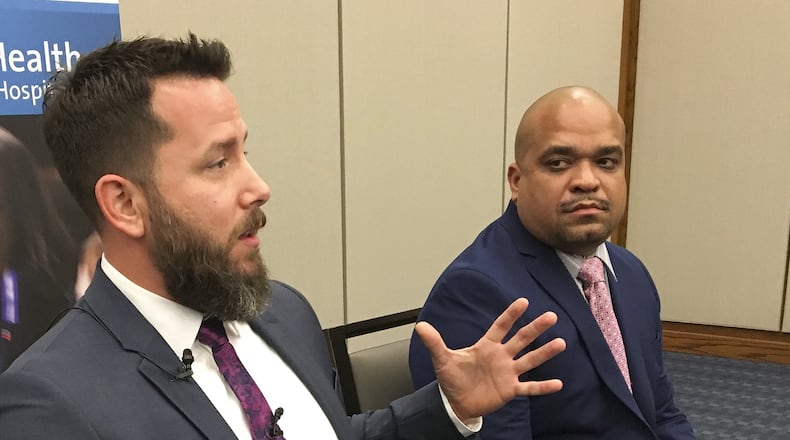RELATED: Santa Fe High School shooting: 10 dead, 10 injured, suspect charged with capital murder
The June 12, 2016, Pulse shooting in Orlando, Fla., left 50 people dead, including the gunman, making it the country’s deadliest mass shooting until a man opened fire on concert goers from his Las Vegas hotel room window last October.
MORE: Ready to relax and celebrate, local residents find chaos in Las Vegas
On Friday, it was at least 10 people killed and that number wounded in Santa Fe, Texas. On Feb. 14, Granada and Tavarez were giving their presentation in Florida when disturbing news came out of Parkland, not far away. That day, 14 students and three staff members died from gunfire.
Granada and Tavarez, partners for 10 years, were the first two paramedics to roll up the the Pulse and what then was the country’s worst gun massacre.
“We happened to be blocks away when it all started — before it all started,” Granada said.
MORE: Voters split on whether to tear down Pulse Nightclub for memorial, survey says
They heard the first reports on a police radio while chatting outside a hospital with their friend, an off-duty officer. The partners in their ambulance sped followed the officer in his pickup to the night club, where their friend exchanged fire with a suspect.
“It looked like something out of movie. I saw him return fire into the club. I saw him go into the club,” Granada said. “It would be like describing a movie, only you’re in it. You’re living it.”
Soon they encountered the wounded and dying.
“At that point in time you’re trying to do the greatest good for the greatest number of patients, because resources are less than the amount of people injured,” Tavarez said. “It’s a hard choice to make. Because you are looking at young people that would otherwise have a long life ahead of them.”
The two treated and transported 13 patients in five trips back and forth to a hospital.
One issue debated in public safety departments across the country is whether to expose EMS crews to gunfire, they said. While police and medics train for events like mass shootings, procedures typically call for police to end the threat before medics enter a scene.
“It does not work for a mechanism or a machine that is making more patients as fast as you can treat them,” Granada said. “This is the issue everyone is dealing with all over the country … Because you have to have care there within minutes or loss of life occurs.”
‘DO SOMETHING:’ Parkland students angry after Texas shooting
As paramedics, Granada and Tavarez said they can’t control access to guns, but they can educate others how to treat penetrating gunshot and stab wounds where seconds are the difference between life and death.
Thinking fast at the Pulse nightclub, the two transformed defibrillator pads into something rugged enough to stanch bleeding.
“Those are made to stick to anything, everything: blood, sweat, tears, doesn’t matter,” Granada said. “That was one of the main tools we used that morning. We took all our defibrillator pads out of the monitor. We cut the cords off them and now we had eight to 10 occlusive dressings we could literally apply within seconds.”
RELATED: Santa Fe High School Shooting: What to know about Santa Fe Independent School District
Tavarez remains an Orlando firefighter-paramedic. Granada is now vice president of The Rescue Company 1, a critical care training and consultant company. The two were featured speakers at the Premier Health Trauma and Critical Care Update & EMS Symposium attended by about 250 people and 30 exhibitors.
Tavarez said everyone would benefit from knowing lifesaving skills and be prepared to use them.
“We can control who knows how to stop bleeding, how to use tourniquets and hemostatic dressings and all of that stuff that we use as paramedics,” he said. “We may not be able to be there right then and there. So if a school teacher knows how to do this, or the cafeteria person, or the school staff, everybody is empowered to stop bleeding. That’s what’s going to save life.”
MORE: Orlando nightclub shooting: Locals express shock and sadness
About the Author

